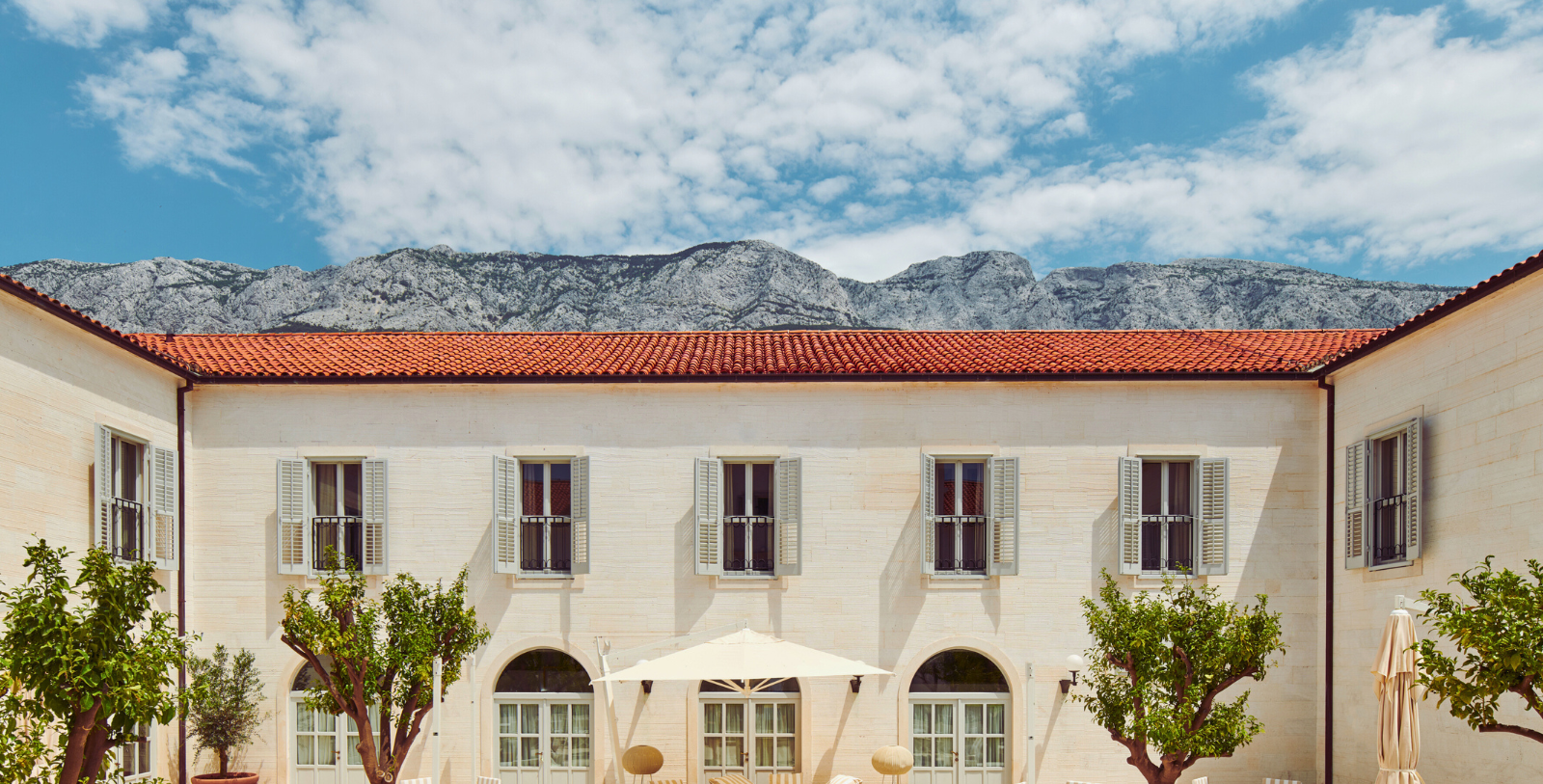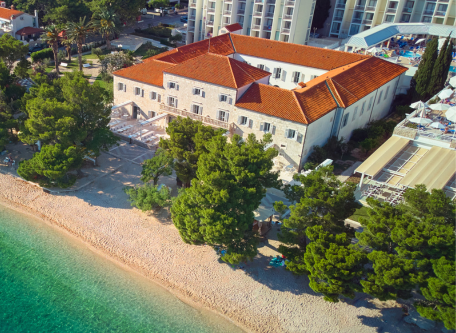Receive for Free - Discover & Explore eNewsletter monthly with advance notice of special offers, packages, and insider savings from 10% - 30% off Best Available Rates at selected hotels.
historic hotel in croatia
Discover Heritage Hotel Kaštelet, which was once the palatial home of an influential noble and enterprising intellectual named Klement Grubišić.
Heritage Hotel Kaštelet, a member of Historic Hotels Worldwide since 2024, dates back to 1766.
VIEW TIMELINEAlthough a major tourist destination today, Croatia’s picturesque Dalmatia region was once an integral part of the historic Venetian Republic at the height of the European Enlightenment. Tons of bustling ports were then dotting its coastline, which accepted all kinds of exotic goods from northern Italy. The prosperous maritime trade brought other aspects of Venetian culture to Dalmatia as well, inspiring some upper-class members to seek it out directly. Among the local aristocrats to embrace the relationship was the influential Grubišić family. Ennobled centuries prior, the Grubišićs hailed from a small seaside village called “Tučepi.” While generations of the family resided in the hamlet, a few of its scions traveled abroad to Venice for long periods of time. One such individual was Klement Grubišić, a trained Jesuit who had gone to the metropolis to study. Earning a doctorate in both theology and law, Grubišic often traveled to Venice to enrich his mind. Perhaps the place where Grubišić spent most of his time was inside the city’s Nani Museum, where he developed a deep fascination with its ancient Croatian runes. This interest, in turn, impassioned the young man to broaden his research to Croatia as a whole, transforming him into an expert on its medieval history and traditions. Nevertheless, the spirited Klement Grubišić returned to Dalmatia upon finding employment as an archbishop’s rector during the 1760s. Despite working in the regional capital of Split, Grubišić still found the time to visit his beloved hometown of Tučepi on occasion and, eventually, decided to move back to the village, constructing a gorgeous manor within the settlement in 1766.
Overlooking the azure waters of the Adriatic, the building was an engineering marvel. Indeed, Grubišić had installed many fantastic features throughout the estate, including gorgeous stone walls and a steeply pitched terracotta roof. Open porches faced out to the sea, while a spacious courtyard functioned as a tranquil oasis inside the palace. Grubišić’s favorite space was his library, though, which he used to produce more research about the Slavic people for the rest of his life. In the wake of his passing in 1773, Grubišić would be remembered fondly for his intellectual work. (For instance, many of his fellow Croatians hailed him for his efforts to advance the research on their historic Slavic language, Glagolitsa.) One of the most lasting monuments to his memory was his magnificent villa, which evolved into a cherished landmark over the next two centuries. The building also continued to function as an upscale residence until noted architect Olga Pavlinović reconfigured it as a boutique hotel during the 1960s. Now known as the “Heritage Hotel Kaštelet,” Grubišić’s beautiful mansion has since continued to serve as a luxurious holiday retreat in the present. This historic hotel in Croatia offers access to over two dozen elegantly designed guestrooms with various upscale amenities and alluring décor. But the hotel’s dedicated management team—Bluesun Hotels & Resorts—also ensured that Klement Grubišić’s legacy continues to endure on-site for future generations to appreciate. Undoubtedly, this fantastic historic site is one that cultural heritage travelers will certainly enjoy.
-
About the Location +
The quaint seaside village of Tučepi resides within Dalmatia, one of Croatia’s four historical regions. Dalmatia possesses a rich heritage that dates back to the arrival of Indo-European people, who are today remembered as the “Illyrians.” Migrating to the area around the 8th century B.C., the Illyrians gradually emerged as the dominant force along the Croatian coastline for several centuries. In fact, the whole region soon became known as “Illyria” among the many other peoples who called the Mediterranean basin home. Nevertheless, the Illyrians eventually came into armed conflict with the burgeoning Roman Empire, which had begun colonizing the various islands situated right off the coast. Unable to withstand the might of Rome, the Illyrians ultimately capitulated to its rule starting in the mid-1st century B.C. Most of Croatia then came to constitute a prominent Roman province called “Dalmatia,” which in turn thrived as an important regional economic center. (One Roman Emperor, Diocletian, even hailed from Dalmatia and built a regal palace in what is now the city of Split.) But this era of immense prosperity ended when the Roman Empire collapsed during the 4th and 5th centuries A.D. A diverse group of civilizations subsequently sought to seize Dalmatia throughout the following Middle Ages, such as the Goths and the Byzantines. However, local rulers managed to gradually reassert control, uniting most of the Croatian lands to create the Kingdom of Croatia in the 10th century.
Meanwhile, a small enclave of communities to the south—including the site of present-day Tučepi—formed a feudal chiefdom recorded as the “Pagania of the Narentines.” A maritime-based civilization, the Pagania of the Narantines sent out numerous pirate ships to prowl the Adriatic Sea for passing merchant fleets. Among their most prolific targets were the boats operated by the Venetian Republic, which led to war erupting between the two societies. After years of fighting, The Venetians defeated the Pagania of the Narantines, formally incorporating the polity into its own domain as “Venetian Dalmatia” during the late 15th century. The region then spent the next several generations as part of the powerful Republic of Venice, benefiting greatly from the latter’s prolific trade network. Dozens of commercial ports quickly dotted the Dalmatian landscape, witnessing countless ships arrive daily. Venetian culture also started to influence indigenous customs, especially those practiced among the local nobility. (For instance, a few prominent aristocratic families in Tučepi—such as the Grubišićs, Ivaniševićs and Kačićs—began infusing elements of Italian art and architecture into their own palatial residences.) Dalmatia’s close affiliation to Venice had its consequences, though. Indeed, the region often served as a frontier against the republic’s various rivals, including the imposing Ottoman Empire. Many coastal communities became havens for the refugees fleeing the Ottoman armies that frequently attacked the larger area.
Despite the looming threat of war, Dalmatia continued to prosper well into the middle of the 18th century. However, Dalmatia unfortunately suffered an abrupt economic crisis with the dissolution of the Republic of Venice amid the tumultuous Napoleonic Wars. The region continued to exist within a couple of French client states for a while until the final dissolution of the First French Empire in 1815. Dalmatia then found itself a fief of the Austrian Empire and its successor, Austria-Hungary, before eventually joining the newly formed nation of Yugoslavia in the wake of World War I. Although briefly seized by the Axis powers later during World War II, Dalmatia remained part of Yugoslavia for nearly the rest of the 20th century. (For reference, Croatia finally became an independent state in 1991.) Interestingly, the region began emerging as a prominent tourist destination around that time, most notably, a tranquil, three-mile stretch of shoreline referred to as the “Makarska Riviera.” All the communities lining the Makarska Riviera soon developed reputations for their picturesque scenery and enviable Mediterranean climate, including the home of today’s Heritage Hotel Kaštelet, Tučepi. Tučepi and the Makarska Riviera as a whole have since remained incredibly popular, hosting countless contemporary vacationers every year. This number has also included thousands of cultural heritage travelers who have yearned to discover Dalmatia’s extensive past. Tučepi has even served as a terrific launchpad toward exploring that story further, being only a short distance from major historic sites located in other communities like Split, Trogir, and Dubrovnik.
-
About the Architecture +
The general appearance of the Heritage Hotel Kaštelet displays some beautiful Baroque-themed architecture. Baroque architecture can trace its roots back to the start of the 17th century when French architects began to practice the style en masse. The architectural form materialized after the Mannerist design aesthetics that preceded it at the height of the Renaissance. The French had begun to mimic a new architectural school of thought that had debuted further south in the Italian Peninsula. The Vatican had grown weary of its declining influence across Europe amid the Protestant Reformation and sought innovative ways to demonstrate its cultural power. One of the many avenues that the church ultimately embraced was the use of architecture to showcase its wealth and prestige. As such, the Italian architects under its employ started creating massive structures that emphasized opulence and grandeur. Inspired by the movement, many French noblemen incorporated similar design principles into their own buildings. However, while the style quickly became ubiquitous across France, its greatest champion was French king Louis XIV. Known to history as the “Sun King,” he particularly enjoyed the idea of “Baroque” architecture as a source of power.
King Louis XIV subsequently used it to create the Grand Trianon and Les Invalides and completely transform his father’s quaint hunting estate outside of Paris into the luxurious Château de Versailles. What made Baroque so attractive to the French aristocracy was its use of grandiose details to achieve an awe-inspiring ambiance. French architects achieved such a feat using elements like colonnades, cupolas, domes, cartouches, and extensive gilding. Brilliant artwork adorned the walls inside French-inspired Baroque structures, too, appearing either as a quadratura or trompe-l'œil paintings. The style nonetheless called for relied extensively on symmetry, in which highly stratified floorplans granted a sense of hierarchy and order. Interestingly, the development of the surrounding landscape was also an integral component of Baroque structures, as manicured gardens helped to reinforce their aura of great magnificence. Thus, Baroque’s appeal spread gradually throughout the rest of Europe, eventually reaching destinations as far away as the area of modern Croatia. Indeed, the development of Baroque architecture is among the most noteworthy on the continent today, with many surviving structures preserved as cherished historical landmarks.


























